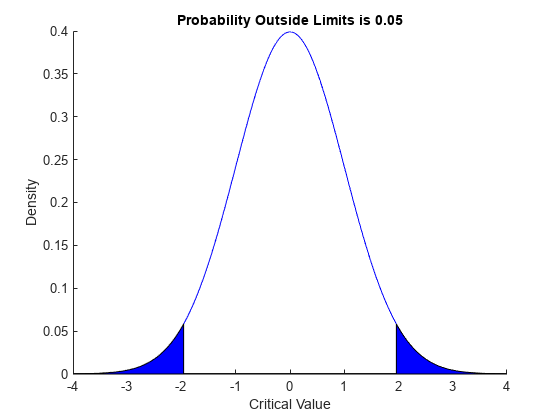icdf
逆累积分布函数
语法
说明
示例
通过指定分布名称 'Normal' 和分布参数,计算正态分布的 icdf 值。
定义输入向量 p 以包含用于计算 icdf 的概率值。
p = [0.1,0.25,0.5,0.75,0.9];
计算均值 等于 1、标准差 等于 5 的正态分布的 icdf 值。
mu = 1;
sigma = 5;
y = icdf('Normal',p,mu,sigma)y = 1×5
-5.4078 -2.3724 1.0000 4.3724 7.4078
y 中的每个值对应于输入向量 x 中的一个值。例如,在值 x 等于 1 时,对应的 icdf 值 y 等于 7.4078。
创建一个正态分布对象,并使用该对象计算正态分布的 icdf 值。
创建均值 等于 1、标准差 等于 5 的正态分布对象。
mu = 1; sigma = 5; pd = makedist('Normal','mu',mu,'sigma',sigma);
定义输入向量 p 以包含用于计算 icdf 的概率值。
p = [0.1,0.25,0.5,0.75,0.9];
计算正态分布在 p 中的值处的 icdf 值。
x = icdf(pd,p)
x = 1×5
-5.4078 -2.3724 1.0000 4.3724 7.4078
x 中的每个值对应于输入向量 p 中的一个值。例如,在值 p 等于 0.9 时,对应的 icdf 值 x 等于 7.4078。
创建一个泊松分布对象,使用的速率参数 等于 2。
lambda = 2; pd = makedist('Poisson','lambda',lambda);
定义输入向量 p 以包含用于计算 icdf 的概率值。
p = [0.1,0.25,0.5,0.75,0.9];
计算泊松分布在 p 中的值处的 icdf 值。
x = icdf(pd,p)
x = 1×5
0 1 2 3 4
x 中的每个值对应于输入向量 p 中的一个值。例如,在值 p 等于 0.9 时,对应的 icdf 值 x 等于 4。
您也可以不创建概率分布对象而直接计算同样的 icdf 值。使用 icdf 函数,并使用相同的速率参数值 指定泊松分布。
x2 = icdf('Poisson',p,lambda)x2 = 1×5
0 1 2 3 4
icdf 值与使用概率分布对象计算的值相同。
创建一个标准正态分布对象。
pd = makedist('Normal')pd =
NormalDistribution
Normal distribution
mu = 0
sigma = 1
通过计算 2.5% 的上限值和下限值,确定具有标准正态分布的检验统计量在 5% 显著性水平下的临界值。
x = icdf(pd,[.025,.975])
x = 1×2
-1.9600 1.9600
对 cdf 绘图,并对临界域进行着色。
p = normspec(x,0,1,'outside')
p = 0.0500
输入参数
概率分布名称,指定为下表中的概率分布名称之一。
name | 分布 | 输入参数 A | 输入参数 B | 输入参数 C | 输入参数 D |
|---|---|---|---|---|---|
'Beta' | Beta Distribution | a 第一个形状参数 | b 第二个形状参数 | 不适用 | 不适用 |
'Binomial' | Binomial Distribution | n 尝试次数 | p 每次尝试成功的概率 | 不适用 | 不适用 |
'BirnbaumSaunders' | Birnbaum-Saunders Distribution | β 尺度参数 | γ 形状参数 | 不适用 | 不适用 |
'Burr' | Burr Type XII Distribution | α 尺度参数 | c 第一个形状参数 | k 第二个形状参数 | 不适用 |
'Chisquare' 或 'chi2' | Chi-Square Distribution | ν 自由度 | 不适用 | 不适用 | 不适用 |
'Exponential' | Exponential Distribution | μ 均值 | 不适用 | 不适用 | 不适用 |
'Extreme Value' 或 'ev' | Extreme Value Distribution | μ 位置参量 | σ 尺度参数 | 不适用 | 不适用 |
'F' | F Distribution | ν1 分子自由度 | ν2 分母自由度 | 不适用 | 不适用 |
'Gamma' | Gamma Distribution | a 形状参数 | b 尺度参数 | 不适用 | 不适用 |
'Generalized Extreme Value' 或 'gev' | Generalized Extreme Value Distribution | k 形状参数 | σ 尺度参数 | μ 位置参量 | 不适用 |
'Generalized Pareto' 或 'gp' | Generalized Pareto Distribution | k 尾部指数(形状)参数 | σ 尺度参数 | μ 阈值(位置)参数 | 不适用 |
'Geometric' | Geometric Distribution | p 概率参数 | 不适用 | 不适用 | 不适用 |
'Half Normal' 或 'hn' | Half-Normal Distribution | μ 位置参量 | σ 尺度参数 | 不适用 | 不适用 |
'Hypergeometric' 或 'hyge' | Hypergeometric Distribution | m 总体的大小 | k 总体中具有所需特征的项数 | n 抽取的样本数量 | 不适用 |
'InverseGaussian' | 逆高斯分布 | μ 尺度参数 | λ 形状参数 | 不适用 | 不适用 |
'Logistic' | 逻辑分布 | μ 均值 | σ 尺度参数 | 不适用 | 不适用 |
'LogLogistic' | Loglogistic Distribution | μ 对数值的均值 | σ 对数值的尺度参数 | 不适用 | 不适用 |
'LogNormal' | 对数正态分布 | μ 对数值的均值 | σ 对数值的标准差 | 不适用 | 不适用 |
'Loguniform' | Loguniform Distribution | a 下部端点(最小值) | b 上部端点(最大值) | 不适用 | 不适用 |
'Nakagami' | Nakagami 分布 | μ 形状参数 | ω 尺度参数 | 不适用 | 不适用 |
'Negative Binomial' 或 'nbin' | Negative Binomial Distribution | r 成功次数 | p 单次尝试的成功概率 | 不适用 | 不适用 |
'Noncentral F' 或 'ncf' | Noncentral F Distribution | ν1 分子自由度 | ν2 分母自由度 | δ 非中心参数 | 不适用 |
'Noncentral t' 或 'nct' | Noncentral t Distribution | ν 自由度 | δ 非中心参数 | 不适用 | 不适用 |
'Noncentral Chi-square' 或 'ncx2' | Noncentral Chi-Square Distribution | ν 自由度 | δ 非中心参数 | 不适用 | 不适用 |
'Normal' | 正态分布 | μ 均值 | σ 标准差 | 不适用 | 不适用 |
'Pearson' | Pearson Distribution | μ 均值 | σ 标准差 | γ 偏度 | κ 峰度 |
'Poisson' | 泊松分布 | λ 均值 | 不适用 | 不适用 | 不适用 |
'Rayleigh' | 瑞利分布 | b 尺度参数 | 不适用 | 不适用 | 不适用 |
'Rician' | Rician Distribution | s 非中心参数 | σ 尺度参数 | 不适用 | 不适用 |
'Stable' | Stable Distribution | α 第一个形状参数 | β 第二个形状参数 | γ 尺度参数 | δ 位置参量 |
'T' | Student's t Distribution | ν 自由度 | 不适用 | 不适用 | 不适用 |
'tLocationScale' | t Location-Scale Distribution | μ 位置参量 | σ 尺度参数 | ν 形状参数 | 不适用 |
'Uniform' | Uniform Distribution (Continuous) | a 下部端点(最小值) | b 上部端点(最大值) | 不适用 | 不适用 |
'Discrete Uniform' 或 'unid' | Uniform Distribution (Discrete) | n 最大可观测值 | 不适用 | 不适用 | 不适用 |
'Weibull' 或 'wbl' | Weibull Distribution | a 尺度参数 | b 形状参数 | 不适用 | 不适用 |
示例: 'Normal'
概率分布,指定为下表中的概率分布对象之一。
输出参量
替代功能
icdf 是泛型函数,它按名称 name 或概率分布对象 pd 接受分布。使用分布特有的函数更快,例如正态分布特有的 norminv,二项分布特有的 binoinv。有关特定于分布的函数的列表,请参阅Supported Distributions。
扩展功能
用法说明和限制:
输入参量
name必须为编译时常量。例如,要使用正态分布,请将coder.Constant('Normal')包含在codegen(MATLAB Coder) 的-args值中。输入参量
pd可以是 beta、指数、极值、对数正态、正态和威布尔分布的拟合概率分布对象。通过对来自fitdist函数的样本数据进行概率分布拟合,创建pd。有关示例,请参阅Code Generation for Probability Distribution Objects。
有关代码生成的详细信息,请参阅 Introduction to Code Generation 和 General Code Generation Workflow。
此函数完全支持 GPU 数组。有关详细信息,请参阅在 GPU 上运行 MATLAB 函数 (Parallel Computing Toolbox)。
版本历史记录
在 R2006a 之前推出
MATLAB Command
You clicked a link that corresponds to this MATLAB command:
Run the command by entering it in the MATLAB Command Window. Web browsers do not support MATLAB commands.
选择网站
选择网站以获取翻译的可用内容,以及查看当地活动和优惠。根据您的位置,我们建议您选择:。
您也可以从以下列表中选择网站:
如何获得最佳网站性能
选择中国网站(中文或英文)以获得最佳网站性能。其他 MathWorks 国家/地区网站并未针对您所在位置的访问进行优化。
美洲
- América Latina (Español)
- Canada (English)
- United States (English)
欧洲
- Belgium (English)
- Denmark (English)
- Deutschland (Deutsch)
- España (Español)
- Finland (English)
- France (Français)
- Ireland (English)
- Italia (Italiano)
- Luxembourg (English)
- Netherlands (English)
- Norway (English)
- Österreich (Deutsch)
- Portugal (English)
- Sweden (English)
- Switzerland
- United Kingdom (English)